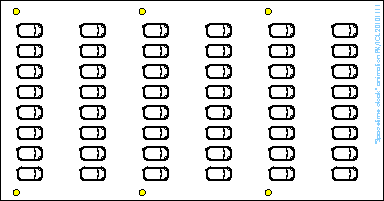| Nov 16, 2010 |
Spacetime cloak to conceal events revealed in new study
|
|
(Nanowerk News) |
|
Research published today, Tuesday 16 November 2010, in IOP Publishing's Journal of Optics ("A spacetime cloak, or a history editor"), explains how the propagation of light can be manipulated to create a 'temporal void', allowing undetectable moments of invisibility.
|
|
The study, by researchers from Imperial College London, involves a new class of materials called metamaterials, which can be artificially engineered to distort light or sound waves. With conventional materials, light typically travels along a straight line, but with metamaterials, scientists can exploit a wealth of additional flexibility to create undetectable blind spots. By deflecting certain parts of the electromagnetic spectrum, an image can be altered or made to look like it has disappeared.
|
|
Previously, a team led by Professor Sir John Pendry at Imperial College London showed that metamaterials could be used to make an optical invisibility cloak. Now, a team led by Professor Martin McCall has mathematically extended the idea of a cloak that conceals objects to one that conceals events.
|
|
"Light normally slows down as it enters a material, but it is theoretically possible to manipulate the light rays so that some parts speed up and others slow down," says McCall, from the Department of Physics at Imperial College London. When light is 'opened up' in this way, rather than being curved in space, the leading half of the light speeds up and arrives before an event, whilst the trailing half is made to lag behind and arrives too late. The result is that for a brief period the event is not illuminated, and escapes detection. Once the concealed passage has been used, the cloak can then be 'closed' seamlessly.
|
|
Such a space-time cloak would open up a temporary corridor through which energy, information and matter could be manipulated or transported undetected. "If you had someone moving along the corridor, it would appear to a distant observer as if they had relocated instantaneously, creating the illusion of a Star-Trek transporter," says McCall. "So, theoretically, this person might be able to do something and you wouldn't notice!"
|
 |
| How the "space-time" cloak works.
|
|
While using the spacetime cloak to make people move undetected is still science fiction, there are many serious applications for the new research, which was funded by the Engineering and Physical Sciences Research Council (EPSRC) and the Leverhulme Trust. Co-author Dr Paul Kinsler developed a proof of concept design using customised optical fibres, which would enable researchers to use the event cloak in signal processing and computing. A given data channel could for example be interrupted to perform a priority calculation on a parallel channel during the cloak operation. Afterwards, it would appear to external parts of the circuit as though the original channel had processed information continuously, so as to achieve 'interrupt-without-interrupt'.
|
|
Alberto Favaro, who also worked on the project, explains: "Imagine computer data moving down a channel to be like a highway full of cars. You want to have a pedestrian crossing without interrupting the traffic, so you slow down the cars that haven't reached the crossing, while the cars that are at or beyond the crossing get sped up, which creates a gap in the middle for the pedestrian to cross. Meanwhile an observer down the road would only see a steady stream of traffic." One issue that cropped up during their calculations was to speed up the transmitted data without violating the laws of relativity. Favaro solved this by devising a clever material whose properties varied in both space and time, allowing the cloak to be formed.
|
|
"We're sure that there are many other possibilities opened up by our introduction of the concept of the spacetime cloak,' says McCall, "but as it's still theoretical at this stage we still need to work out the concrete details for our proposed applications."
|
|
Metamaterials is an expanding field of science, with a vast array of potential uses, spanning defence, security, medicine, data transfer and computing. Many ordinary household devices that work using electromagnetic fields could be made more cheaply or to work at higher speeds. Metamaterials could also be used to control other types of waves as well as light, such as sound or water waves, opening up potential applications for protecting coastal or offshore installations, or even engineering buildings to withstand earthquake waves.
|

